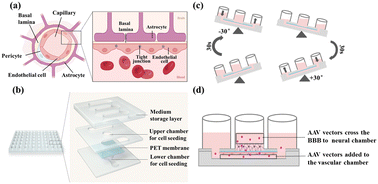LY6E protein facilitates adeno-associated virus crossing in a biomimetic chip model of the human blood–brain barrier†
Abstract
The blood–brain barrier (BBB) controls chemical access to the brain and maintains fluid homeostasis, but in vitro models accurately simulating the physiological characteristics of the BBB are lacking. Here, we describe a simple and reproducible biomimetic chip-based model of the human BBB. In this bilayer co-culture, astrocytes and brain microvascular endothelial cells (BMECs) are respectively seeded in upper and lower chambers separated by a semi-permeable membrane, with fluid shear force provided by a precision tilt shaker. Evaluation of barrier crossing by fluorescein sodium, 40 kDa or 70 kDa FITC-dextran, or adeno-associated virus (AAV) particles demonstrates that this bilayer model provides similar or greater barrier function than Transwell assays. Comparison of AAV serotypes indicated that AAV-PHP.eB can cross the human BBB in vitro, and at higher efficiency than AAV9. Additionally, RNAi knockdown and virus capsid protein binding assays show that AAV-PHP.eB delivery is facilitated by receptor protein lymphocyte antigen-6E (LY6E) in humans. This in vitro model system uses a miniaturized chip to enable high-throughput investigations of AAV crossing efficiency in the BBB, and provides strong initial evidence that human LY6E mediates AAV-PHP.eB crossing the BBB.



 Please wait while we load your content...
Please wait while we load your content...